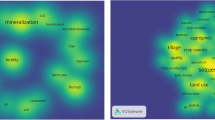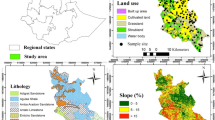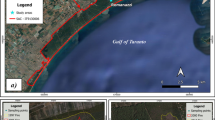Abstract
Based on the regularities of changes in the accumulation, composition, and properties of the microstructural components separated from virgin chernozems by granulodensimetric fractionation, an hypothesis relating the mechanisms of the microaggregate formation and stability with the spatial and temporal distribution of the soil organic matter was confirmed. Schemes were composed for describing the relationships of the soil microstructure with the stability of the organic matter and the dynamics of its renewal in chernozems. Parameters were proposed for characterizing the equilibrium status of soil organic matter.
Similar content being viewed by others
References
Z. S. Artem’eva and L. S. Travnikova, “Transformation of Organic Matter and Clay Minerals in Cultivated Gray Forest Soils,” Pochvovedenie, No. 1, 96–107 (2006) [Eur. Soil Sci. 39 (1), 84–94 (2006)].
A. Ya. Vanyushina and L. S. Travnikova, “Organic-Mineral Interactions in Soils: A Review,” Pochvovedenie, No. 4, 1–10 (2003) [Eur. Soil Sci. 36 (4), 379–387 (2003)].
K. K. Gedroits, Selected Works (Nauka, Moscow, 1975) [in Russian].
M. M. Kononova, Soil Organic Matter (Akad. Nauk SSSR, Moscow, 1963) [in Russian].
Recommendations for Studying the Budget and Transformation of Organic Matter under Agricultural Use and High-Input Management of Soils (Moscow, 1984) [in Russian].
T. M. Sileva, “Development of the Mineralogical Component of Chernozems in the Cisvolga Forest-Steppe,” in Ecology and Soils: Selected Lectures of the X All-Russian School (Pushchino, 2001), pp. 320–325 [in Russian].
T. M. Sileva and O. V. Chernova, “Characterization of Soils of the Ostrovskii and Kuncherovskii Plots of the Privolzhskaya Lesostep Reserve,” in Proceedings of the Privolzhskaya Lesostep Reserve (Penza, 1999), No. 1, pp. 25–32 [in Russian].
A. N. Sokolovskii, “Phenomena Related to the Colloidal Soil Component,” Izv. Petrovskoi S-Kh. Akad, Nos. 1–4, 85–226 (1921).
N. A. Titova, “The Nature of Humus and Its Bonds with the Mineral Component of Virgin and Arable Dry-Steppe Soils in the Southeastern Regions of European Soviet Union,” in Organic Matter of Virgin and Arable Soils (Nauka, Moscow, 1972), pp. 70–109 [in Russian].
N. A. Titova, “Composition and Nature of Organic Matter in Fine Particles of Virgin Soils of the Arshan-Zelmen Station,” in Physical Chemistry of Soils and Their Fertility (VASKhNIL, Moscow, 1988), pp. 74–82 [in Russian].
L. S. Travnikova, “Use of the Derivatographic Method for the Analysis of Organic Matter in Soils and Particle-Size Fractions,” in Physicochemical Aspects of Soil Fertility (VASKhNIL, Moscow, 1985), pp. 15–22 [in Russian].
L. S. Travnikova, “Regularities Governing the Humus Accumulation: New Data and Their Interpretation,” Pochvovedenie, No. 7, 832–843 (2002) [Eur. Soil Sci. 35 (7), 737–748 (2002)].
L. S. Travnikova and Z. S. Artem’eva, “Physical Fractionation of Soil Organic Matter for Studying Its Resistance to Biodegradation,” in Ecology and Soils: Selected Lectures of the X All-Russian School (Pushchino, 2001), Vol. 4, pp. 337–346 [in Russian].
L. S. Travnikova, I. M. Ryzhova, T. M. Sileva and Yu. V. Buryakova, “Investigation of the Organic Matter of Chernozems from the Volga Forest-Steppe by the Methods of Physical Fractionation,” Pochvovedenie, No. 4, 430–437 (2005) [Eur. Soil Sci. 38 (4), 377–383 (2005)].
L. S. Travnikova and N. A. Titova, “Factors Regulating the Distribution of Organic Matter in Soil Fractions <5 μm of the Solonetzic Complex of Kalmykia,” Pochvovedenie, No. 11, pp. 121–128 (1978).
L. S. Travnikova, N. A. Titova, and M. Sh. Shaimukhametov, “Role of Interaction Products between the Organic and Mineral Components in the Genesis and Fertility of Soils,” Pochvovedenie, No. 10, 81–96 (1992).
A. F. Tyulin and T. A. Malomakhova, “Fractional Peptization as a New Method of Studying Soil Colloids,” Khim. Sots. Zemled., No. 12 (1934).
D. V. Khan, Organo-Mineral Compounds and Soil Structure (Nauka, Moscow, 1969) [in Russian].
M. Sh. Shaimukhametov, “Use of Ultrasound in Studying the Immobilization of Organic Matter in the Soil,” Pochvovedenie, No. 5, 154–161 (1974).
M. Sh. Shaimukhametov, N. A. Titova, L. S. Travnikova, and E. M. Labenets, “Use of Physical Fractionation Methods for Characterizing Soil Organic Matter,” Pochvovedenie, No. 8, 131–141 (1984).
M. Sh. Shaimukhametov, V. A. Devyatykh, and E. A. Korzhueva, “Efficiency of Ultrasonic Disintegration of Soils,” in Physicochemical Aspects of Soil Fertility: Proceedings of the Dokuchaev Soil Science Institute (Moscow, 1985), pp. 22–28 [in Russian].
W. Amelung and W. Zech, “Organic Compounds of Ultrasonically Dispersible and Nondispersible Clay Fractions in an Oxisol, Brazil,” in Proceedings of the 16th World Congress of Soil Science, Montpellier, France, 1998, p. 81.
D. W. Anderson, S. Suggar, J. R. Betany, and J. W. Stewart, “Particle Size Fractions and Their Use in Studies of Organic Matter: The Nature and Distribution of Forms of Carbon, Nitrogen, and Sulfur,” Soil Sci. Soc. Am. J. 45(4), 767–773 (1981).
B. T. Christensen, “Physical Fractionation of Soil and Structural and Functional Complexity in Organic Turnover,” Eur. J. Soil Sci. 52, 345–353 (2001).
C. Chenu, P. Puget, and J. Balesdent, “Clay-Organic Matter Associations in Soils: Microstructure and Contribution to Soil Physical Stability,” in Proceedings of the 16th World Congress of Soil Science, Montpellier, France, 1998, Symp. 4, No. 1973.
A. P. Edwards and J. M. Bremner, “Microaggregates in Soils,” J. Soil Sci. 8(1), 64–73 (1967).
E. T. Elliot, “Aggregate Structure and Carbon, Nitrogen, and Phosphorus in Native and Cultivated Soils,” Soil Sci. Soc. Am. J. 50, 627–633 (1986).
W. W. Emerson, “The Determination of the Stability of Soil Crumbs,” J. Soil Sci. 5, 233–250 (1954).
B. Guillet, “Study of the Turnover of Soil Organic Matter Using Radioisotopes,” in Constituents and Properties of Soils (London, New York, 1982), pp. 238–257.
D. S. Jankinson and J. H. Rayner, “The Turnover of Soil Organic Matter in Some Rothamsted Classical Experiments,” Soil Sci. 123(5), 298–309 (1977).
A. Golchin, J. M. Oades, J. O. Skjemstad, and P. P. Clarke, “Study of Free and Occluded Particulate Organic Matter in Soils by Solid State 13C CP-MAS NMP Spectroscopy and Scanning Electron Microscopy,” Austr. J. Soil Res. 32, 285–309 (1994).
A. Golchin, J. M. Oades, J. O. Skjemstad, and P. Clarke, “Soil Structure and Carbon Cycling,” Aust. J. Soil Res. 32, 1043–1068 (1994).
A. Golchin, J. M. Oades, J. O. Skjemstad, and P. Clarke, “Structural and Dynamic Properties of Soil Organic Matter as Reflected by 13C NMR Spectroscopy in Density Fractions of an Oxisol under Forest and Pasture,” Aust. J. Soil Res. 33, 59–76 (1995).
E. G. Gregorich, C. F. Drury, and B. H. Ellert, “Fertilization Effects on Physically Protected Light Fraction Organic Matter,” Soil Sci. Soc. Am. J. 61, 482–484 (1997).
G. Guggenberger, W. Zech, L. Haumaier, and B. T. Christensen, “Land-Use Effects on the Composition of Organic Matter in Particle-Size Separates of Soils: II. CPMAS and Solution 13C NMR Analysis,” Eur. J. Soil Sci. 46, 147–158 (1995).
A. P. Hamblin, “Structural Features of Aggregates in Some East England Silt,” J. Soil Sci. 28(3), 23–28 (1977).
A. P. Hamblin and D. B. Dowies, “Influence of OM on the Physical Properties of Some East England Soils of High Silt Content,” J. Soil Sci. 28(1), 11–22 (1977).
J. Hassink, “Decomposition Rate Constants of Size and Density Fractions of Soil Organic Matter,” Soil Sci. Soc. Am. J. 59, 1631–1635 (1995).
M. Korschens, A. Weigel, and E. Schulz, “Turnover of Soil Organic Matter (SOM) and Long-Term Balances-Tools for Evaluating Sustainable Productivity of Soils,” Z. Pflanzenernaehr. Bodenk-d. 161, 409–424 (1998).
M. Muneer and J. M. Oades, “The Role of Ca-Organic Interactions in Soil Aggregate Stability: III. Mechanisms and Models,” Aust. J. Soil Sci. 27, 411–423 (1989).
L. M. Neto, A. E. Andriulo, and D. G. Traghetta, “Effect of Cultivation on ESR Spectra of Organic Matter from Soil Size Fractions of a Mollisol,” Soil Sci. 157(6), 365–372 (1994).
J. M. Oades, “Influence of Clay Mineral and Associated Compound on Soil Physical Properties,” in Proceedings of the 16th World Congress of Soil Science, Montpellier, France, 1998, p. 80.
J. M. Oades, A. M. Vassallo, A. G. Waters, and M. A. Wilson, “Characterization of Organic Matter in Particle Size and Density Fractions from a Red-Brown Earth by Solid-State 13C NMR,” Aust. J. Soil Res. 25(1), 71–82 (1987).
J. M. Oades and A. C. Waters, “Aggregate Hierarchy in Soils,” Aust. J. Soil Res. 29, 815–828 (1991).
E. A. Paul and J. A. van Veen, “The Use of Tracers to Determine the Dynamic of Organic Matter,” J. Soc. Soil Sci. 3, 91–102 (1978).
A. Piccolo, “Hydrophobic Interactions Controlling Molecular Sizes of Humic Molecules in Soils: Effects on the Accumulation and Decomposition of Soil Organic Matter,” in Proceedings of the 16th World Congress of Soil Science, Montpellier, France, 1998.
J. O. Skjemstad, L. J. Janic, and J. A. Taylor, “Non-Living Soil Organic Matter: What We Know About It?,” Austr. J. Exp. Agric. 38, 667–680 (1998).
J. M. Tisdall and J. M. Oades, “Organic Matter and Water-Stable Aggregates in Soils,” J. Soil Sci. 33, 141–163 (1982).
L. S. Travnikova, N. A. Titova, B. M. Kogut, et al., “Evaluation of the Different SOM Pools Stability in Some Long-Term Experiments of Germany by Physical Fractionation,” Arch. Acker-Pflanzenbau Bodenkd. 48, 565–576 (2002).
Author information
Authors and Affiliations
Additional information
Original Russian Text © L.S. Travnikova, T.M. Sileva, I.M. Ryzhova, Z.S. Artem’eva, 2006, published in Pochvovedenie, 2006, No. 6, pp. 712–720.
Rights and permissions
About this article
Cite this article
Travnikova, L.S., Sileva, T.M., Ryzhova, I.M. et al. Microaggregation and stability of organic matter in the forest-steppe chernozems of the Volga region. Eurasian Soil Sc. 39, 640–647 (2006). https://doi.org/10.1134/S1064229306060081
Received:
Accepted:
Issue Date:
DOI: https://doi.org/10.1134/S1064229306060081




